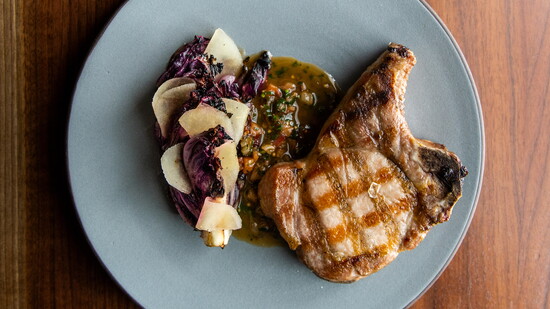Stepping through the doors of The Dixboro Project, it’s clear that every detail was planned with intention. The wide-plank floors, soft lighting, and elegant rusticity of the historic barn that was converted into the restaurant’s main seating area set the tone for a refined and inviting evening. Beautifully crafted cocktails are served in sparkling glassware, modern art adorns the walls, and the atmosphere is elevated but welcoming.
And then the food arrives, and it helps tell an even deeper, more layered story.
When the fried chicken lands at the table—golden, crisp and gleaming, along with a honey butter biscuit that can’t possibly taste as good as it looks but is somehow better—you realize this isn’t just comfort food dressed up. This is a carefully considered homage and the kind of dish that looks timeless but holds its own against the thoughtfully designed fine dining menus of today’s best restaurants.
That balance, between memory and invention, is the philosophy behind every dish at The Dixboro Project. “There’s a couple of points on a triangle that guide us,” says Executive Chef Garrett Lipar. “Americana; sustainability and local food systems; and respect for the classics. We want to build a restaurant that could stand for another 100 years.”
The restaurant itself sits on seven and a half acres in Dixboro Village, on land that has housed four different restaurants across the last century. It’s a property steeped in history: in the 1920s, The Farm Cupboard welcomed travelers and farmers, serving home cooked meals in cast-iron pans and biscuits made from scratch. A generation later, The Lord Fox turned the space into one of the area’s best-known fine dining restaurants.
The Dixboro Project honors both legacies in their own fried chicken, which has become a cornerstone of today’s menu.
“We couldn’t find the original recipe from The Farm Cupboard,” Lipar says. “So we looked at old cookbooks and records from the same time period and adapted it to the flavors available locally.”
Today’s version is made with locally raised chicken that’s brined, broken down into parts, and fried to a distinctive crispness. It’s served with those mind-blowingly good honey butter biscuits from Executive Pastry Chef Jin Capobianco, and a rotating array of pickled and fermented vegetables grown on-site or by nearby farmers.
“What we love about it is that it’s communal,” Lipar says. “Almost every large table orders it to share. It resonates across generations.”
If the chicken anchors the savory menu, the Baked Alaska is its sweet counterpoint. Once a showstopping table-side performance at The Lord Fox, today it has been reimagined by Chef Capobianco for modern diners.
Her version is individually plated, striking to look at yet nimble enough for a restaurant that serves dozens every day. “It starts with a strawberry semifreddo base,” Capobianco explains. “Then I pipe a Swiss meringue around it. I like to use toasted sugar in my meringue to cut the sweetness and bring out a nutty caramelization. We finish it with rhubarb jam, fresh macerated strawberries, and edible flowers.”
It’s still flamed just before arriving at the table, a nod to tradition, but the flavors and nostalgia are all there.
The philosophy extends even to something as simple as the restaurant’s hamburger. It’s one of the best-selling items on the menu, made with Michigan Wagyu from Stone Fall Farms, served on a potato sesame seed roll baked fresh daily.
“If a burger or a pizza or a salad is delicious,” Lipar says, “it doesn’t need to be over-explained. It just needs to be excellent.”
Just as the property’s earliest restaurants relied on nearby farms, The Dixboro Project continues that tradition today. On-site, a production garden provides herbs and a small amount of other vegetables. But it’s partnerships with local farmers that shape the menu seasonally—eggs from Webbed Foot Farms, mushrooms from Stoney Creek, beef from Stone Fall Farms, berries from the west side of Michigan. This network of relationships grounds the menu in place, turning every dish into both a reflection of the land and a collaboration with the people who tend it.
And then there’s the bakery, featuring croissants that have developed a following of their own, and a chocolate cake guests now order whole or by the slice. The Dixboro Project insists on the classics done with care. “Trends come and go,” Capobianco said. “But if we can connect people to something timeless, that’s the kind of food people never forget.”
At first glance, the menu at The Dixboro Project reads like fine dining. It has farm-to-table sourcing, beautifully composed plates, and heritage recipes reimagined for a modern palate. But the team isn’t chasing ego-driven artistry. It’s seeking something more human—connection.
“All food should be comforting,” Lipar says. “We want food that connects with people. That’s what brings them back.”
Learn more at thedixboroproject.com.
“Trends come and go. But if we can connect people to something timeless, that’s the kind of food people never forget.”
— Executive Pastry Chef Jin Capobianco
